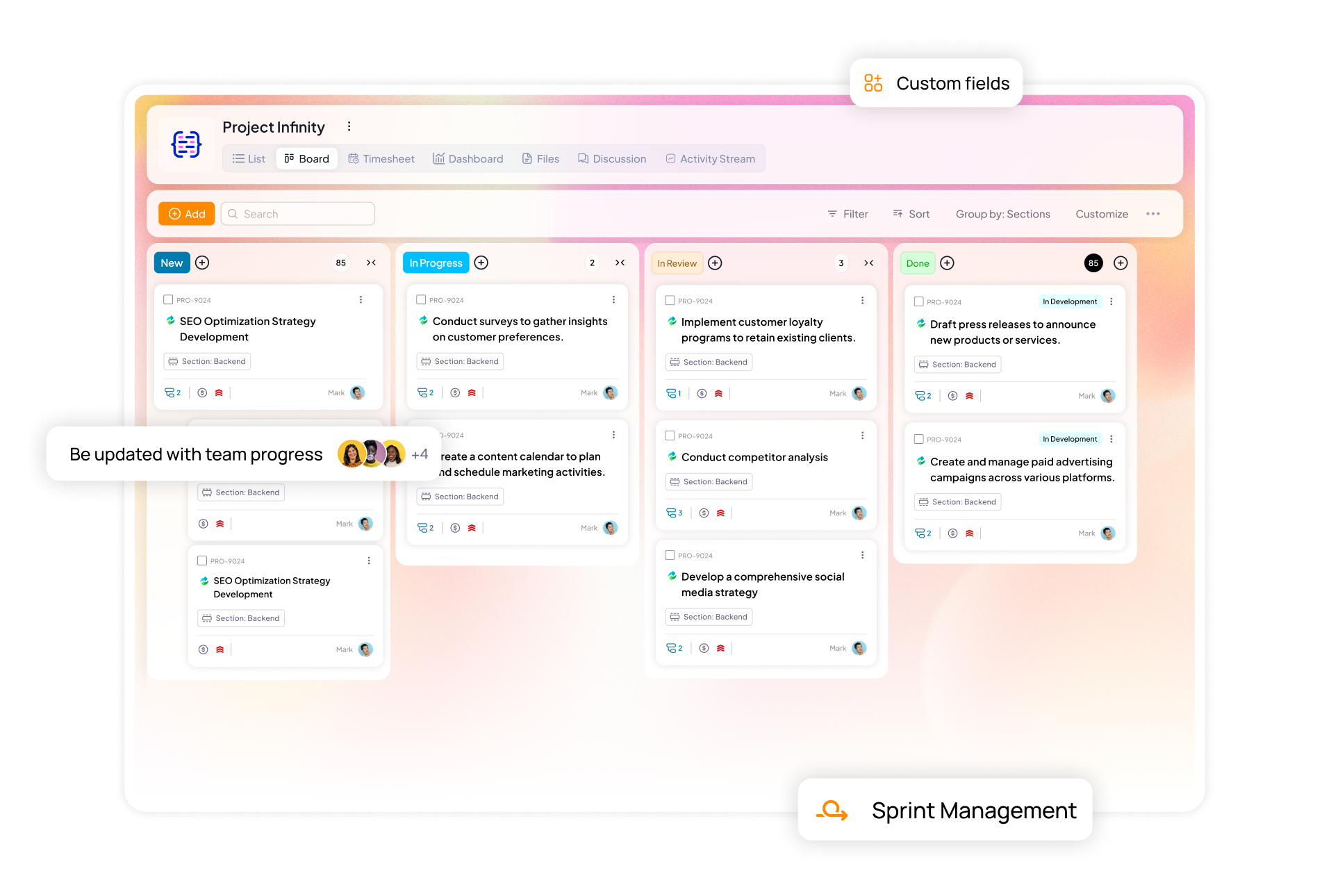Scope creep is a leading reason why marketing projects run late or go over budget. It happens when project requirements expand beyond the original project lifecycle without adjustments to time or resources.
For example, a three-post campaign evolving into a full content calendar. This may seem like a small request, but without controls, they pile. Suddenly, a two-week project stretches into two months.
Fortunately, it’s possible to prevent scope creep in marketing. With the right systems and setting boundaries early, marketing teams can deliver projects on time and within budget.
In this guide, you’ll learn what is scope creep in project management, its causes, proven strategies to prevent it, and how pro teams use tools to stay in control.
Main causes of scope creep in marketing projects
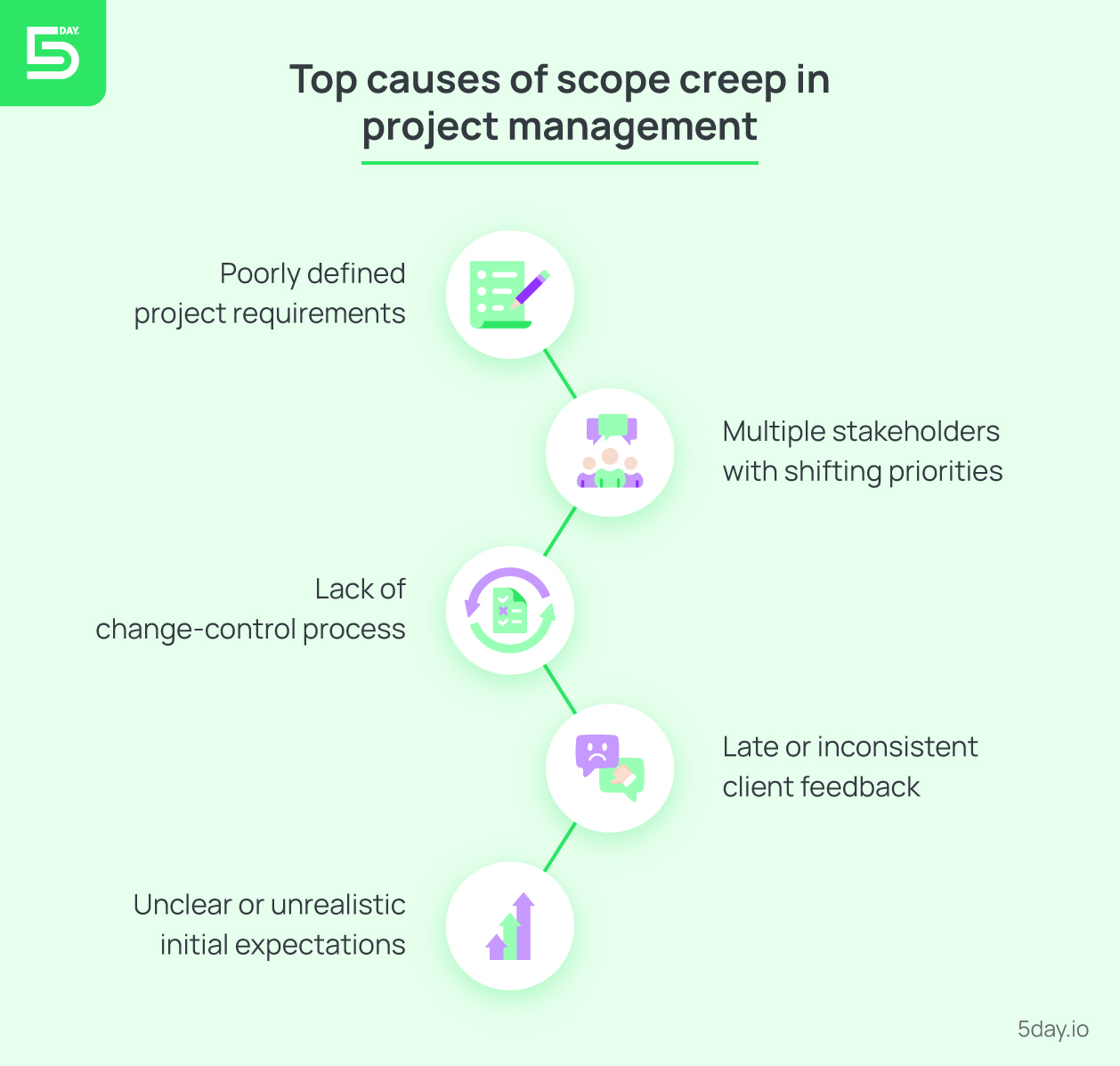
Understanding why scope creep happens is the first step to preventing it. Let’s first look at the most common causes of scope creep in marketing projects.
1. Unclear project requirements
Vague briefs such as, make the website modern or create engaging posts, leave room for interpretation. That ambiguity quickly turns into unplanned revisions. A clearer scope means fewer assumptions.
2. Multiple stakeholders and shifting priorities
Several decision-makers working on a project often means more requests. Research shows that projects with too many stakeholders and communication gaps lead to a significantly higher risk of scope creep.
Everyone thinks differently, and one thing or another leads to shifting priorities.
3. Weak or missing change-control processes
Without a process to evaluate new requests, teams fall into the yes mode. Small changes pile up without assessing the impact. Saying yes to everything without structure fuels uncontrolled expansion.
4. Late or inconsistent client feedback
Marketing projects thrive on timely feedback. When clients deliver feedback late or contradict earlier approvals, they force teams to redo entire sections of work. This not only delays projects but wastes resources as well.
5. Unrealistic initial expectations
If goals, timelines, or budgets don’t match reality, scope creep becomes inevitable. A vague request, like grow engagement fast, without resource alignment, sets everyone up for failure.
Proven strategies to prevent scope creep in marketing
Now, the question is how to prevent scope creep in marketing projects. Well, the best way to stop scope creep is to prevent it from creeping in at all.
You can start by defining and documenting the scope clearly from day one. This means holding a thorough kickoff meeting and creating a detailed project brief or contract that spells out the deliverables and deadlines.
But that’s not it. Seasoned teams use the following best strategies to help lock down expectations from day one.
1. Create crystal-clear project documentation
A strong project scope is your insurance policy. A detailed scope document specifies deliverables, quantities, formats, approval rounds, and explicit exclusions.
Here’s what to include in a marketing project scope:
- Objectives: Specific, measurable goals (for example, increase traffic by 30% in 90 days)
- Deliverables: Instead of just mentioning social media content, include the exact outputs (like 12 Instagram posts, 4 LinkedIn articles, monthly report, etc.)
- Asset specifications: Include dimensions, file formats, color profiles, and technical requirements
- Exclusions: What’s not included (e.g., video assets if only static was agreed)
- Timeline with milestones: Break projects into phases with clear deadlines
- Approval process: Define how many revision rounds are included and who has final approval authority
- Success criteria: Project KPIs, approval process, definition of “done”
Pro tip: Use phrases like “specifically includes” and “specifically excludes” to eliminate assumptions. It means that the more detailed your scope document is, the harder it is for creep to sneak in.
2. Create a formal change-control process
Build a clear workflow for handling new requests. Whenever changes are necessary, make sure everyone knows what they should do. Here’s how you can have a formal change-control process in place.
- Document the change request in writing
- Analyze the impact of change on time, budget, responsibility, and resources
- Provide the updated cost and timeline
- Secure written stakeholder approval
- Record the change in official documentation
This helps prevent scope creep chaos by requiring any new feature or task to go through an official change request process.
3. Master stakeholder communication
During kickoff and regular check-ins, communicate how changes affect the project. Such regular updates keep expectations aligned.
For this, use:
- Weekly status reports for visibility
- Milestone reviews to reset alignment
- Monthly scope reviews to catch early signs of expansion
When discussing changes, try the Scope Sandwich Technique.
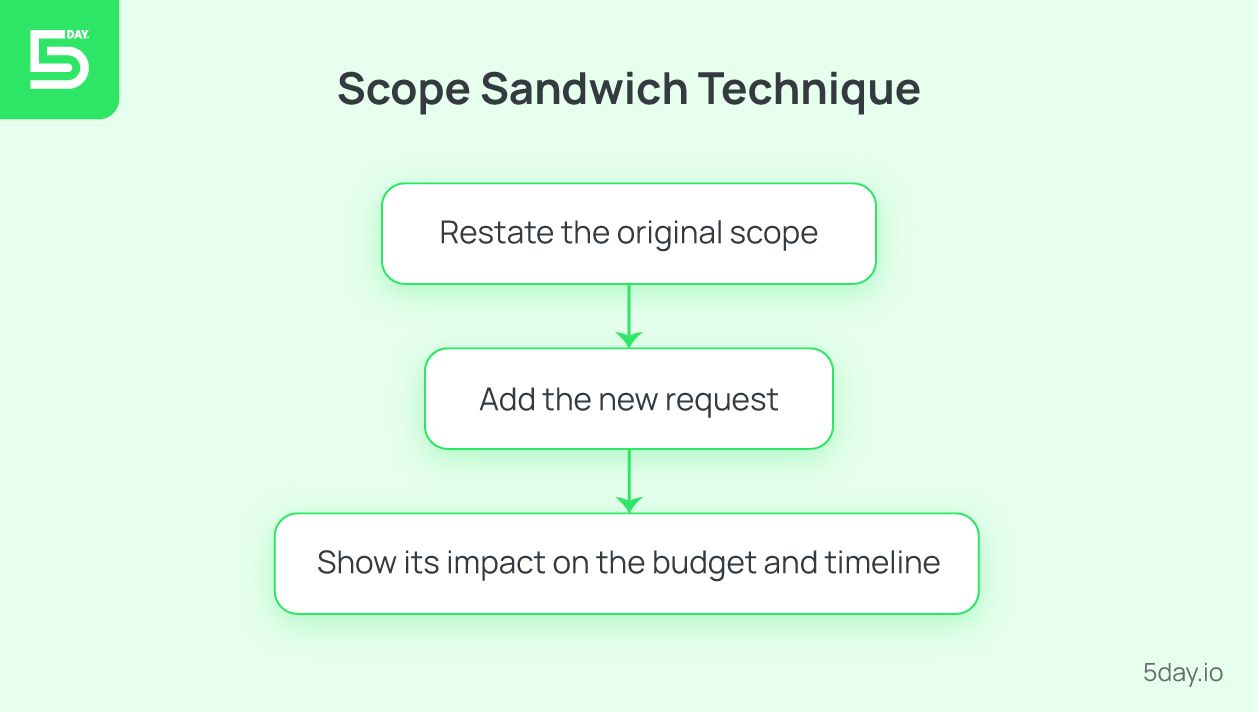
Transparent communication prevents surprise scope creep and keeps all the stakeholders in the loop to avoid any confusion.
4. Set boundaries early
Boundaries create professionalism and reduce unnecessary friction. You can set boundaries right at the start by defining:
- Revisions included (like 2 or 3 rounds)
- Feedback deadlines for clients
- Communication protocols (for instance, requests via the project management communication feature, not through emails)
As a result, these set boundaries protect both your team and your client relationship.
5. Build buffer into project plans
Add a 15–20% buffer to time estimates and scope. This allows flexibility for small, expected adjustments. A buffer plan helps absorb minor changes without derailing the project.
Most projects go through several changes from the initial plans, and the buffer time gives room to adjust those changes.
Handling scope creep when it happens
Even with prevention practices in place, scope creep will occasionally show up. The key is to address it quickly and professionally. Let’s look at the scope creep management plan to take control.
1. Recognize red flags early
Pay attention to casual requests like can we just add… or this shouldn’t take long. They often seem minor at first, but can expand the scope if teams overlook this aspect.
While you have practices to prevent scope creep in digital marketing projects, recognizing these red flags makes it easy to reduce the damage.
2. Respond with clarity
When a new request appears, use this framework to manage scope creep.
- Acknowledge the request
- Refer back to the original scope
- Outline the impact in terms of deadline and budget extension (extra 2 weeks, $3,000)
- Provide options like add it now with changes, or defer to next phase
3. Document decisions for future clarity
Keep a scope change log noting the request, impact, decision, and updated plan. This helps adjust your scope creep prevention plan for the next phase.
Address scope creep immediately, with documentation, so it never becomes a silent problem.
Best practices to manage scope creep for marketing agencies and teams
Marketing teams and agencies often face unique scope challenges. So, here are some agency-specific best practices:
1. Document everything from the start
Agencies that miss important details might face extended timelines. Make clear scopes of work (SOWs) or statement of work documents standard for every project.
Include exact deliverables, rounds of revisions allowed, and assumptions. Document every agreement, change, or addition to keep everything transparent.
2. Limit revision rounds and clarify sign-offs
Don’t let projects linger indefinitely on edits. Set a fixed number of review cycles as discussed earlier, like two rounds of feedback. Make it clear that once a phase is approved, further changes will need re-evaluation. This minimizes endless back-and-forth.
3. Train your team on scope management
Empower your project managers to spot scope creep and speak up. They should feel comfortable explaining to clients how extra requests affect time/cost. Build a culture where scope questions are raised early, instead of sweeping them under the rug.
4. Promote open client communication
Keep clients in the loop with progress reports or project management dashboards. Use the right tools and client-accessible dashboards so clients see their status themselves. When clients have real-time visibility into project progress, they’re less likely to make surprise demands or misjudge how far along you are.
5. Treat new ideas as opportunities, not emergencies
One clever approach is to reframe scope creep as upselling. Scope creep is tricky, but having the right plan to make changes helps. That’s why it’s better to view expanded requests as opportunities to grow revenue.
In practice, that might mean offering clients a premium retainer or add-on package for significant changes. This way, everyone wins as clients get what they want, and the agency isn’t squeezed at the last minute.
6. Create a scope management plan
PMI experts often recommend a formal scope management plan. This plan forms part of the overall project plan and explains how the team defines and controls the scope. Build this into your standard process early so everyone understands the rules of engagement.
By following these best practices, agencies and marketing teams can dramatically reduce firefighting and maintain healthier project margins. Use the right project management tools for documentation, to set clear limits on edits, strong client communication, and a proactive mindset.
How does a 5day.io help prevent scope creep?
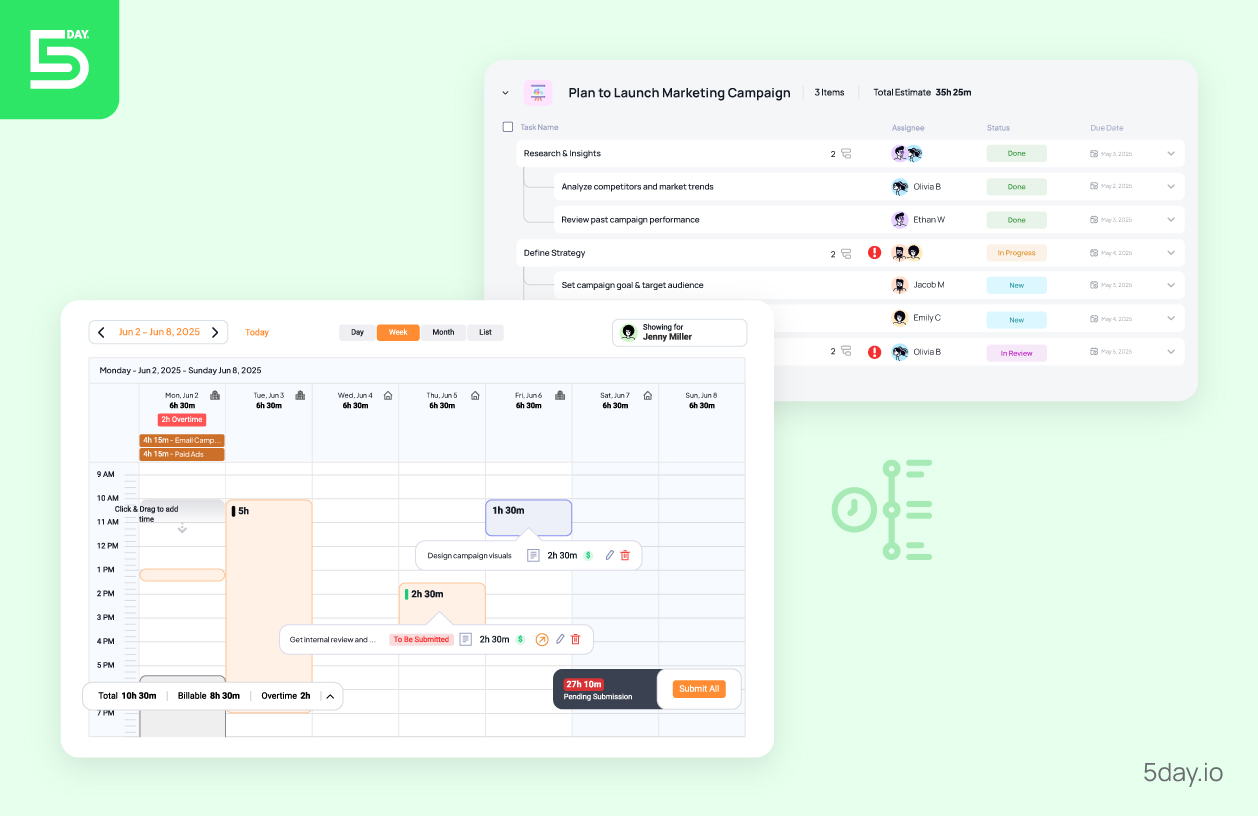
Technology helps the project management process scale. 5day.io is one such project management tool that offers built-in features that keep marketing teams in control.
With 5day.io, marketing teams can prevent scope creep using:
- Centralized scope documentation to store briefs, deliverables, and approvals in one place, leaving no room for confusion about what’s agreed
- Project dependencies and timelines to see how one change affects the rest of the project instantly
- Time tracking helps monitor actual vs. estimated hours to flag early signs of creep
- Client portal access to give clients transparency without handing them control of the entire project
- Detailed analytics & reporting help identify patterns of scope creep across clients and projects for smarter future planning
Managing scope creep to increase project efficiency
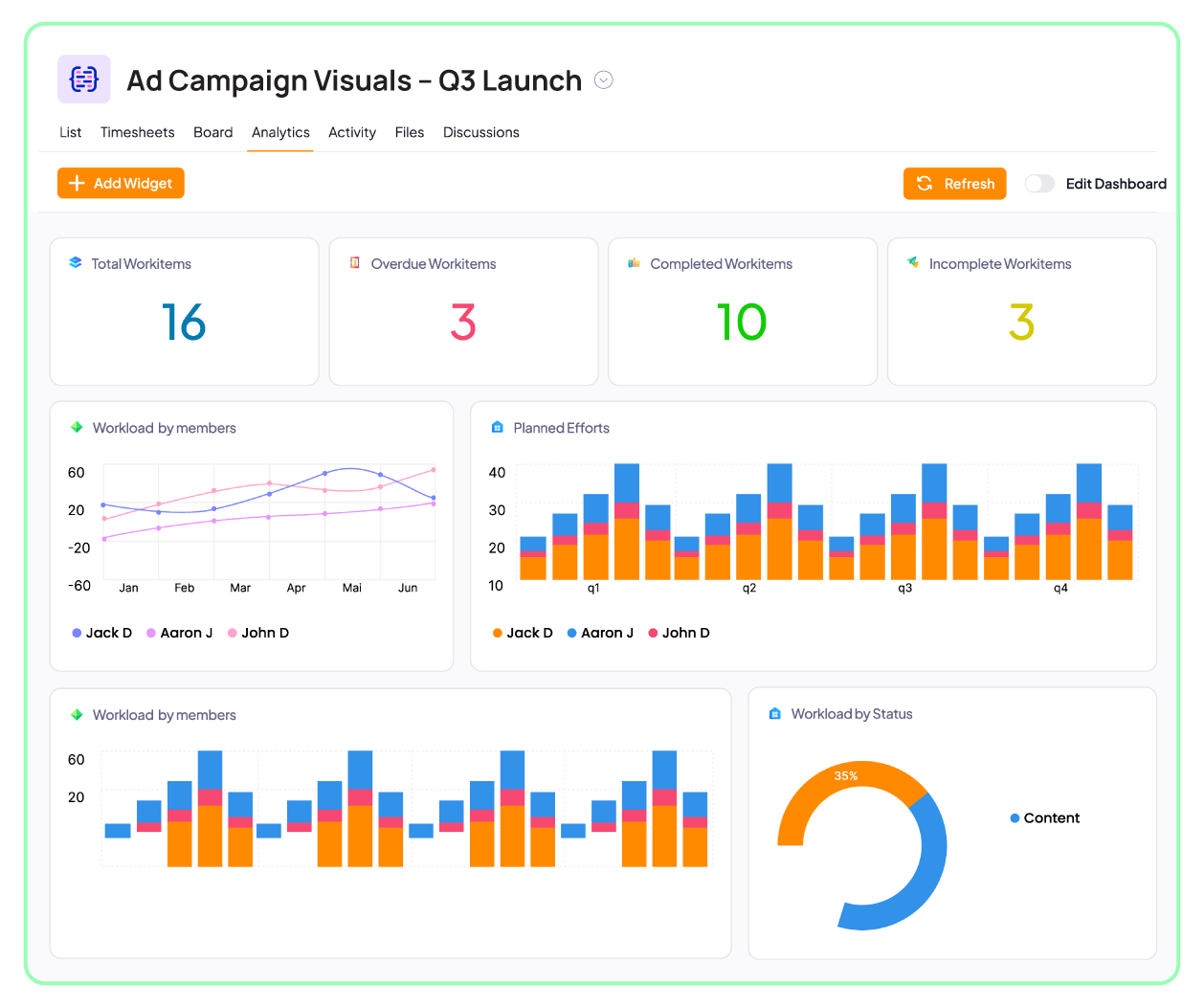
Scope creep can derail your marketing projects. You can keep projects focused and profitable with clear documentation, structured change processes, strong communication, and the right tools.
Here are some key points to help prevent scope creep in digital marketing projects:
- Prevention is more effective than correction, so take steps early on
- Communication solves more scope creep than technical fixes
- Formal processes protect both clients and teams
- Tools like 5day.io make scope control scalable and transparent
When you set boundaries and manage scope proactively, you protect not only your project outcomes but also your client relationships and team morale.
Ready to move from scope creep to scope control? Try 5day.io for marketing teams today and see how structured project management transforms your marketing workflow. Use it for 30 days free (no credit card needed).






